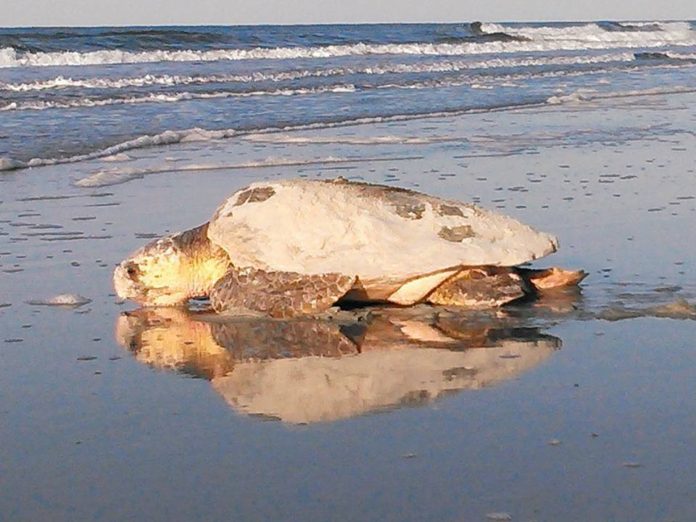Nestled in the warm, protective sand on Fripp Island is a little turtle nursery – nests, created by mama turtles and populated by many soft, round eggs. Just the fact that these nests exist is, in itself, somewhat of a wonder because recently a small miracle took place. It happened while we weren’t paying attention, as miracles have a tendency to do.
Here it is. Far away, perhaps hundreds of miles away, a female Loggerhead Turtle felt a little tug. I’m not a turtle, so I can’t explain exactly what that tug felt like, but whatever the sensation was, it caused the 250 pound turtle to set her internal navigation system and start swimming toward Fripp Island where, some 20 years or so ago, she hatched from her egg. Humans are such proprietary creatures; we think we’re the only ones who feel a longing for home but, apparently, we aren’t alone in that somewhat inexplicable feeling. For, you see, the female Loggerhead Turtle also feels that little pull that draws her back home. She remembers the place from which she came and, even if it means swimming a very long way, will return to the beach where she herself hatched to make a place for her little ones to start their lives.
I must say that, for a turtle, this seems pretty remarkable and there’s something about it that makes me feel kind of small and, well, reverent in a way. I, too, have often overcome many barriers to follow an internal tugging of heart strings and make a trip home from a place thousands of miles away. They are, of course, different barriers than our turtle friend and none were life-threatening, but they were obstacles nonetheless and sometimes seemed dauntingly insurmountable. I feel that we’re a little connected, she and I.
So she makes this significant trip overcoming who knows what – strong currents, predators, all the power of the sea and the things in it…and finally makes it home to Fripp Island to lay her eggs. She makes her way out of the surf where, again, her instinct comes into play and she chooses a place on the beach where she thinks her babies will be safe from marauding raccoons, hungry ghost crabs, and curious beach visitors.
And then she does another seemingly difficult thing. She covers her eggs with sand then turns around and heads back to the ocean, leaving her babies behind. She won’t ever see her little ones. She’ll never know if they actually hatched safely and made it to the ocean. She can only hope that, even if they do make it into the surf, they live long enough to tell about it.
It must be really hard to be a mother turtle.
Fortunately, though, while fate will always have the upper hand because that’s just the way nature works, her little ones will at least have a fighting chance to make it to the ocean. Enter the Fripp Island Turtle Team, a group of volunteers who work to protect the nests and the hatchlings so they have the best chance possible.
And there are rules to govern our somewhat thoughtless and bungling human behavior. Starting May 1, it’s “Lights Out” on Fripp Island, in keeping with county and city ordinances. Through October 31, no artificial lighting can be visible from the beach at night, in an effort to help moms and hatchlings stay oriented to the ocean. Their instincts tell them to follow the light which, in this particular case, is a good thing since celestial light guides our reptilian friends to the surf. But they’re easily disoriented by other types of lights and, in their inability to discern natural light from artificial light, may head the wrong direction and end up in someone’s back yard instead.
Personally, I wouldn’t want to be responsible for guiding a baby turtle away from the ocean after all its mother did to give it a good start in life.
All in all, it’s a pretty noteworthy process and you can’t help but want to cheer the little ones on as they emerge from the sand like so many actors from “The Walking Dead” and, shaking the sand off, immediately start actively inching their way to the water. No one taught them to do this. They just know, in the same way their mother just knew she had to go home.
There’s a lot we can learn from the story of the Loggerhead Turtle; lessons on persistence, courage, and remembering our roots. And how fun it is to cheer the little ones on as they start their lives in the vast and scary ocean, hoping that their predators will have already eaten lunch when the little guys finally make it to the water’s edge. Because as Dr. Seuss so wisely wrote, “And the turtles, of course….all the turtles are free, as turtles and, maybe, all creatures should be.”
Originally written as ‘The Miracle of Returning Home – A Turtle Story’, by Elizabeth Bishop Later for A Place Called Home: A memoir of Beaufort and St. Helena Island, South Carolina. You can read more from the book and writings of Sonny Bishop and Elizabeth Bishop Later at BishopsBest.com










